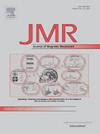400 MHz/263 GHz ultra-low temperature MAS-DNP using a closed-cycle helium gas cooling system and a solid-state microwave source
IF 1.9
3区 化学
Q3 BIOCHEMICAL RESEARCH METHODS
引用次数: 0
Abstract
Dynamic nuclear polarization (DNP) is widely used in a wide range of applications in solid-state NMR nowadays due to recent advancements of magic-angle spinning (MAS) DNP. Conventionally, an MAS-DNP system employs a gyrotron as a microwave source and operates at 100 K using nitrogen gas. As an alternative, we present a 400 MHz/263 GHz MAS-DNP system utilizing a compact solid-state microwave source and an ultra-low temperature (ULT) helium MAS probe equipped with a cryogenic preamplifier. Compared to gyrotrons, solid-state microwave sources are compact, cost-effective, and frequency agile. The ULT compensates for the decreased DNP efficiency resulting from the lower microwave power of the solid-state source. Additionally, the large Boltzmann polarization at ULT and the improved signal-to-noise ratio provided by the cryogenic preamplifier enhance the sensitivity of the MAS-DNP system. The system is tested using a DNP standard sample of proline in a mixture of deuterated glycerol and partially deuterated water doped with AMUPol, achieving a DNP enhancement of 85 using a 2 mm-diameter rotor at a sample temperature of 30 K and microwave power of 160 mW. Experimental data show that the Boltzmann polarization and the cryogenic preamplifier contribute an additional sensitivity gain of 11 at 30 K compared to 100 K. Overall, the ULT-DNP related sensitivity gain of this system is estimated to be roughly twice that of a 100 K gyrotron system, although the DNP enhancement factor alone is smaller using a solid-state microwave source.

400 MHz/263 GHz超低温MAS-DNP采用闭式循环氦气冷却系统和固态微波源
由于魔角自旋(MAS)动态核极化(DNP)技术的发展,动态核极化(DNP)技术在固体核磁共振中得到了广泛的应用。传统上,MAS-DNP系统采用回旋管作为微波源,使用氮气在~ 100 K下工作。作为替代方案,我们提出了一种400 MHz/263 GHz MAS- dnp系统,该系统利用紧凑型固态微波源和配备低温前置放大器的超低温(ULT)氦MAS探头。与回旋管相比,固态微波源结构紧凑,成本效益高,频率灵活。ULT补偿了由于固体源的微波功率较低而导致的DNP效率下降。此外,低温前置放大器提供的大玻尔兹曼偏振和改进的信噪比提高了MAS-DNP系统的灵敏度。该系统使用脯氨酸DNP标准样品在掺有AMUPol的氘化甘油和部分氘化水的混合物中进行测试,在样品温度为30 K,微波功率为160 mW的条件下,使用直径为2 mm的转子实现DNP增强85。实验数据表明,与100 K相比,玻尔兹曼偏振和低温前置放大器在30 K下的灵敏度增益增加了11倍。总体而言,该系统的ULT-DNP相关灵敏度增益估计大约是100 K回旋管系统的两倍,尽管使用固态微波源的DNP增强因子较小。
本文章由计算机程序翻译,如有差异,请以英文原文为准。
求助全文
约1分钟内获得全文
求助全文
来源期刊
CiteScore
3.80
自引率
13.60%
发文量
150
审稿时长
69 days
期刊介绍:
The Journal of Magnetic Resonance presents original technical and scientific papers in all aspects of magnetic resonance, including nuclear magnetic resonance spectroscopy (NMR) of solids and liquids, electron spin/paramagnetic resonance (EPR), in vivo magnetic resonance imaging (MRI) and spectroscopy (MRS), nuclear quadrupole resonance (NQR) and magnetic resonance phenomena at nearly zero fields or in combination with optics. The Journal''s main aims include deepening the physical principles underlying all these spectroscopies, publishing significant theoretical and experimental results leading to spectral and spatial progress in these areas, and opening new MR-based applications in chemistry, biology and medicine. The Journal also seeks descriptions of novel apparatuses, new experimental protocols, and new procedures of data analysis and interpretation - including computational and quantum-mechanical methods - capable of advancing MR spectroscopy and imaging.

 求助内容:
求助内容: 应助结果提醒方式:
应助结果提醒方式:


